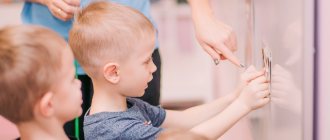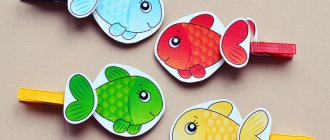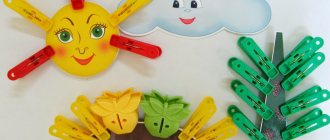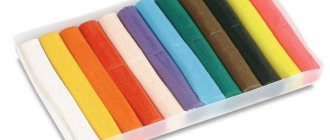Game "Scissors"
Purpose of the game: coordination of movements, training of hand muscles, concentration, development of fine motor skills of the hands.
Materials needed: a tray with scissors (preferably plastic ones with blunt ends) and several sheets of thick colored paper. Some sheets have cut lines marked.
Progress of the game: The presenter asks a riddle: Two ends, two rings, and a carnation in the middle. After the child has guessed correctly, the presenter offers to cut the paper with scissors. If the child did it easily, he is given the task of cutting along the lines and performing complex movements to cut out the pattern.
It should be taken into account that, having acquired the skills to confidently hold scissors, the child will then be able to hold a pencil and draw precise lines on paper with the same confidence.
Game "Little Pharmacist"
Purpose of the game: development of fine motor skills; finger movements, coordination.
Materials needed: On a small tray are tweezers, a cup with beads and a platform with slots for beads. There are exactly as many beads in the cup as there are cells in the platform. Each cell should be colored to match the color of the beads. You can use more beads at the beginning.
Progress of the game: The presenter talks about pharmacists and how they prepare various medicines. Shows how to transfer beads using tweezers. Then he invites the child to fill the cells with beads. When the platform is full, the beads are transferred back using tweezers. The game can be complicated by changing the size of the beads and platform cells. However, it should be taken into account that the game is quite complex and requires the child to have extreme concentration and internal control when working. If a child's bead falls onto the tray, he can always correct the mistake. Since the game requires great precision in movements, it is necessary to note each successful action of the baby.
Game "Colored Drops"
Purpose of the game: development of fine motor skills, finger movements, concentration, coordination.
Materials needed: On a tray is a platform for freezing water in the refrigerator. At the top, the platform is divided into three overlaps of red, blue and yellow. Next to the tray are 3 bottles of colorful water. The water is colored with yellow, red and blue food colors (you can use sparkling water). Each bottle contains a pipette with a thick rubber cap. Little sponge.
Progress of the game: The presenter shows how to transfer water from different bubbles using a pipette to the corresponding cells of the platform. The child repeats, and gradually the cells are filled with water in accordance with their color. The water is then transferred back into the vials using pipettes.
The child not only develops his fingers by working with a pipette, but also trains in the differentiation and distribution of colors, in their comparison and discrimination.
Game "Find the surprise"
Purpose of the game: development of fine motor skills of the hands, coordination of movements; teaching patience.
Necessary materials: candy wrappers (10-15 pieces), small items (badges, buttons, pebbles, etc.).
Progress of the game: The presenter wraps the badge in 4-5 candy wrappers. The child must unwrap all the candy wrappers and fold them carefully.
Game "Embroiderers"
Purpose of the game: development of fine motor skills, refined finger movements, concentration, coordination.
Materials needed: On a tray are sheets of cardboard with lines drawn on them. There are simple drawings, and there are more complex ones. There are holes on the lines where the needle and thread will go (in more complex tasks, these holes are only marked with a dot). A ball of woolen thread, 1-2 thick needles.
Progress of the game: The presenter talks about embroiderers, if possible, shows various embroideries and invites the child to play, explaining how they embroider. Then the child takes the needle and inserts the thread into the eye of the needle. At first, an adult helps him with this. Later he does it on his own. The ends of the thread are connected and tied into a knot. Then the child makes stitches on cardboard with holes (for a lighter option, you can use a cord instead of a needle), threading the needle up and down. It should be noted that working with a needle, especially threading and tying a knot, is very difficult for a small child. At first, it’s better not just to show, but to patiently perform these operations together with him, hand in hand, and accurately capture the moment when you can let go of the child’s hand and invite him to act independently.
Game "Lace up your shoe"
Purpose of the game: mastering the skill of dressing, developing fine motor skills, coordination, spatial orientation.
Materials needed: a pair of sneakers and laces.
Progress of the game: The presenter shows how to lace a sneaker and asks the child to lace the second sneaker in the same way. During the game, you must first show the lacing option and lace up with your child. As the game becomes more complex, you can only show ready-made samples.
Game "Beads"
Purpose of the game: development of fine motor skills, coordination, discrimination by shape and color of objects, concentration.
Necessary materials: thread, buttons of different sizes and colors.
Progress of the game: The presenter invites the child to make beads. You can give the task to make beads according to the sample, choosing buttons according to shape and color.
Game "Colorful clothespins"
Purpose of the game: development of fine motor skills of the hands, training in color discrimination, development of attention.
Materials needed: 2 sets of baskets with clothespins. The clothespins are painted red, yellow, blue, green (3 of each color). The basket can be replaced with a cup or plate, or a plastic bucket. The main thing is that the clothespins easily cling to the edges.
Progress of the game: The leader and the child each have a basket with colored clothespins. The leader takes the basket, puts it on the table and asks the child to give him a clothespin and name its color. If the baby doesn’t know, then the leader names the color himself. Then the presenter shows how you can attach a clothespin to the edge of the basket with three fingers.
When the child masters this action and can easily attach clothespins, for example, all the clothespins are the same color and name their color, he is given the task of attaching the clothespins in a certain color sequence, performing a certain sequence of clothespins as on the leader’s basket. You should pay attention to the fact that the presenter attaches the clothespins with three fingers, because the child must see the correct movements.
Repeated repetition of the movement of unclenching and squeezing clothespins trains the fingertips, provides a tonic massage and pressure on the muscle points responsible for activating the speech centers of the brain.
By observing which hand the child prefers to work with, you can determine the dominant hand. However, it is advisable for the child to work with both hands.
Game "Let's put it in order"
Purpose of the game: development of fine motor skills, coordination, discrimination by shape and color of objects, concentration.
How to play: Pour beads of two colors into a bowl (about 5-7 beads of each color) and place two saucers to the right of the bowl. Suggest: “let’s put all the red beads in one saucer, and all the green ones in the other.” To spice up the game, say, for example, that this is a treat for the bear and the bunny, and the bear only likes cherries, and the bunny only likes gooseberries. You need to move the beads one at a time, taking them with three fingers (show). If some beads fall on the table, ask them to pick them up with a scoop. Be sure to finish the job - this skill is very important. Therefore, at first, take fewer beads.
Game “Sprinkle with a Spoon”
Place two cups on the tray: on the left is a cup with cereal, and on the right is empty. (Both cups should be dry.) First, moving the child's hand, show how to take a partial spoonful of cereal, wait until the cereal stops falling from the spoon, and, smoothly moving your hand, move the spoon to the right cup and tip it over it. Help your baby pick up cereal when there is little left (tell him to bend the cup with his left hand). It is useful to combine this exercise with stirring. For example, a child can pour sugar into tea and place it himself.
Game “Come on, catch it!”
Place two plates on the tray: on the left - deep, and on the right - shallow. Pour water into a deep plate and throw in a few small floating objects. Invite your child to catch them one by one with a spoon and place them in a small plate. At first, help him by guiding his hand slightly. Make sure your child holds the spoon correctly. It is important to complete the exercise, transfer all items to a shallow plate, and collect spilled water with a sponge.
Game “Catch it out of the water”
Pour water into a bowl and throw in a few small floating objects: pieces of cork, twigs, etc. Invite your child to use a small sieve with a handle to catch all these items and place them on a plate on the tray to the right of the bowl. The baby should hold the sieve in his right hand.
Game "Magic Sieve"
Say: “Rice and semolina are mixed in this cup (show grains of rice and semolina separately). How to select all the rice grains from here? This is difficult to do even with your small and dexterous fingers. But a sieve will help you!” Separating one grain from another is like a magic trick for a child. Explain why this happens by first pouring clean semolina into the sieve, and then rice. The sifted rice should be poured into the prepared plate.
Game “Putting the cakes with a spatula”
For this exercise, you can “bake” cakes from plasticine or use small objects (for example, large buttons), or, outside, make them from snow or wet sand. The “cakes” should not be in the shape of balls so that they do not roll off the spatula.
Game “There was a puddle and it’s not there”
This exercise has great educational value: if a child spills something, he will be able to clean up after himself. First, teach your baby to transfer water from one plate to another with a sponge. Place two plates on the tray: on the left with a small amount of water, on the right empty. Demonstrate how to use a sponge by scooping water into one bowl and squeezing it over another. Please note that water should not drip from the sponge onto the tray. Then pour some water on the tray and show them how to wipe up the puddle by scooping it up with a sponge.
Game "Whipping cream"
Pour some water into a bowl and add a few drops of shampoo. Show your baby how to beat by holding the whisk correctly and making clockwise movements. The left hand should hold the bowl at this time. Draw your child's attention to the result - the appearance of foam. When the child begins to beat on his own, help him at first by slightly guiding his hand. Having finished whipping, the child must clean up after himself, carefully wiping away any puddles.
Game "Don't spill and don't spill"
First, pour some cereal into the jug and show your child how, holding the jug with his right hand and holding it with his left, pour the cereal into a glass standing to the left of the jug. (The child should sweep all spilled grains into a dustpan with a brush). Don't forget to discreetly praise your child if he cleaned up neatly. You should move on to transfusion only when the child has mastered oversleeping well. Help him start and finish the transfusion - this is the hardest thing for him. Show how to clean up spilled water with a sponge.
Game “Collecting mushrooms in the forest”
Place pieces of foam rubber on the floor and tell your child: “Here’s a basket for you, try to collect all the mushrooms in the clearing!” Show how to take pieces of foam rubber: with three fingers of your right hand. The collected “mushrooms” must be placed one at a time in the basket. Make sure your child collects all the “mushrooms”: this develops attention and teaches accuracy.
Game "Beads"
Purpose of the game: development of fine motor skills, coordination, discrimination by shape and color of objects, concentration.
Progress of the game: The presenter invites the child to make beads. You can give the task to make beads according to the sample, choosing buttons according to shape and color.
Game "Open and Close"
Come up with a game: for example, the baby can be a doctor who has a lot of jars of medicine, or a housewife who keeps different cereals in jars. Place several small jars with closed lids in front of the child (the jars should be different in size and shape). Offer to open all these jars, and then close them again, choosing the right lids. If the lids screw on, make sure your child twists the lid and not the jar.
Game “Collect all the beads”
Throw pebbles into the sand. (If playing at home, sprinkle on a tray). First, invite your child to collect pebbles with the first three fingers of his right hand (reinforcing the skill). Then show how to use the sieve: hold it in your left hand, and use your right hand to scoop sand into the sieve. The remaining stones in the sieve must be carefully poured into a bucket.
Game “Sprinkle the paths”
Invite your child to sprinkle “sand” (semolina, millet) on a 3-5 cm wide path on the table. Limit it with something, for example, strips of paper. Play: the path can go from one match house to another. Sand should be sprinkled with the same three fingers (folded in a “pinch”) without going beyond the edges of the path. When playing in the yard, you can make a path between two
Game "Find a Pair"
Pick up several pairs of identical small objects, for example two buttons, two cotton balls, two spools, etc. Place them in two identical paper bags: one item from the pair in one bag, the other item from the pair in another bag. Ask your child, without looking, to put his hand into the first bag and pull out any object from there. Now (again without looking) let him try to find by touch the exact same object in the second bag.
Card index of games for the development of fine motor skills
On the table, all the rings are laid out evenly, in increasing sizes to the right of the pyramid. Then the pyramid is assembled in the appropriate order.
Card No. 9
"Search for objects in a bowl of cereal"
Tasks:
Children find it extremely pleasant to tinker, dig through a large amount of homogeneous material, passing grain or sand through their fingers, looking for pebbles or small toys hidden in it. This is beneficial for their psyche, the kids calm down, focus on finding surprises and learn to concentrate and be careful. Develop tactile senses of the fingertips.
Material:
A deep, stable bowl filled with some kind of cereal; several small objects - toys, pebbles 9 objects must be changed periodically to maintain the child’s interest and curiosity).
Description of the game.
The teacher and the child bring the material to the table. We immerse our hands in the cereal and encourage the baby to do the same. “Suddenly” we find the hidden object and place it on the table. We ask the child to find the rest of the hidden objects. We show how you can hide an object back into the cereal by burying it. We focus the child's attention on special care - there should be no cereals on the table. If suddenly some of the cereal accidentally spills, you need to remove it with a table brush.
Card No. 10
"Tying and Untying Bows"
A classic exercise by Maria Montessori, the direct goal of which is to master the ability to tie and untie laces and bows. At the same time, the child learns precise finger movements, sequence of operations and is focused on each step of the work. In this context, tying and untying frames, as well as fastening buttons and buckles, indirectly prepare the child for mastering the writing process.
Material:
A wooden frame with two halves of fabric attached, connected by red and white bows. There are five bows in total.
How to work with the material
.
Unleashing
. The child begins to untie the top bow and always works from top to bottom. He takes the ends of the ribbon with both hands and stretches them to the sides. The top bow, and all the others behind it, are untied. Now we will pry up the knots with our index finger, starting from the top one, and moving forward we untie them too. We straighten the ends of the ribbon to the sides and fold back the halves of the fabric to mark that the bows and knots are completely untied.
Tying.
Connect the halves of the fabric to the center. Let's take the ends of the top braid and throw them in opposite directions. Index finger
Using your left hand, move the tape and form a large loop from it. With your right hand, wrap the other end of the tape around this loop clockwise and insert it into the hole. Stretch the ends of the tape to the sides. The knot is tied. We will also tie the remaining knots, moving from top to bottom. Now let's start tying the bows. We will do exactly the same as with knots, but we will make narrow loops from the ends of the ribbon, gathered towards the base of the bow. In this case, the second loop is carefully pulled out from under the first and the bow itself is aligned.
MAGAZINE Preschooler.RF
Club for developing children’s speech and strengthening fine motor skills “Talking Fingers”MKDOU "Novokhopersky kindergarten of general developmental type No. 3 "Sun" Educational program
Head: Elena Vladimirovna Purzikova, teacher. 2015-2016
Explanatory note
“The sources of children’s abilities and gifts are at their fingertips. From the fingers, figuratively speaking, come the finest streams that feed the source of creative thought.” V. A. Sukhomlinsky
The origins of children's abilities and talents are at their fingertips. Various hand actions and finger games stimulate the process of the child’s speech and mental development, since the development of the hand is closely related to the development of the child’s speech and thinking.
Fine motor skills of the hands also interact with such higher properties of consciousness as attention and thinking. The development of fine motor skills is also important because the child’s entire future life requires the use of precise, coordinated movements of the hands and fingers, which are necessary to dress, draw and write, as well as perform many different everyday and educational activities. A child at this age will benefit from hand exercises in the pre-speech period, and finger games accompanied by poetry will develop speech and listening skills. The preschooler will learn to understand the meaning of what he hears and grasp the rhythm of speech. Finger games create a favorable emotional background, develop the ability to imitate an adult, teach them to listen attentively and understand the meaning of speech, and increase the child’s speech activity. If a child performs exercises, accompanying them with short poetic lines, that is, his speech will become clearer, rhythmic, bright, and control over the movements performed will increase. The child’s memory develops as he learns to remember certain hand positions and sequences of movements. The child develops imagination and fantasy. Having mastered all the exercises. He can “tell” whole stories with his fingers. Typically, a child who has a high level of development of fine motor skills is able to reason logically, his memory, attention, and coherent speech are sufficiently developed. Children's activity based on interests "Talking Fingers" is aimed at developing and strengthening fine motor skills in children 3-5 years old. Classes include a variety of game exercises based on various lexical topics. The work uses materials of different textures (paper, cardboard, fabric of various textures, threads, cereals, buttons, etc.)
Children's activities based on interests are held once a week in the afternoon throughout the school year. Form of work: with subgroups.
Predicted results.
- Children's ability to work with paper;
- Use of figurative toys in theatrical games;
- Develop the ability to hold a pencil (handles will become more flexible and obedient);
- The ability of preschoolers to work independently and creatively;
- Mastering the necessary knowledge and skills in joint activities with teachers.
Purpose of the program:
Development and strengthening of fine motor skills in preschool children in games, exercises and various types of productive activities (drawing, modeling, design), understanding of speech, harmonious development of children.
Tasks:
The program offers solutions to educational, educational and developmental problems, taking into account the age and individual developmental characteristics of preschoolers.
Educational:
- formation of voluntary coordinated movements of the fingers, eyes, flexibility of the hands, rhythmicity development of tactile perception (tactile, skin sensitivity of the fingers)
- formation of practical skills
- teach various skills in working with paper and plasticine.
Educational:
- development of fine motor skills of fingers and hands
- improving hand movements
- development of cognitive mental processes: voluntary attention, logical thinking, visual and auditory perception, memory
- children's speech development.
Educational:
- cultivate moral qualities towards others (kindness, sense of camaraderie, etc.)
- educate and develop artistic taste
- cultivate perseverance and focus.
Pedagogical technologies that ensure the implementation of the educational process.
Pedagogical principles:
- principle of consistency (from simple to complex, from particular to general)
- the principle of a rich object-based play environment for sensory education of children
- the principle of the relationship between sensory, mental and physical development
- the principle of integration of educational, educational and developmental tasks
- the principle of ensuring active cognitive-sensory practice.
Methods and forms:
- Conversations are aimed at creating conditions: for developing the ability to listen, hear, see and notice, observe and perceive.
- Discussion helps develop the ability to speak and prove, and think logically.
- Organizing game situations helps: gain interaction experience, make decisions, take responsibility..
To develop hand motor skills in children's hobby classes, the following techniques are used:
- self-massage of hands;
- finger gymnastics and finger games;
- performing movements with small objects (mosaics, construction sets, cereals, small toys, counting sticks, buttons, beads)
- drawing (with fingers, plasticine, shading according to a pattern, painting, labyrinths) applique, origami.
Providing the program.
Personnel: teacher with higher education.
Material and technical:
To successfully implement the program, you need the following materials and tools:
- rubber toys
- beads, ribbons, bows, buttons, matches, sticks. lacing
- various materials: plastic (dough, plasticine), bulk (cereals, legumes, sand); foam rubber, cotton wool, cotton swabs.
- colored paper, album, markers, glue, pencils
- finger theater figures, etc.
- finger games index
- card index of artistic words (poems, riddles)
- music library (classical works, children's repertoire).
Methodological literature:
- Abramova L.P. “Bushies are lambs. Finger games" . – M.: Karapuz, 2003.
- Agayan G.G. “Visiting the sun. Finger games" . – M.: Karapuz, 2004.
- Agayan G.G. “We stomped, we stomped... Finger games . – M.: Karapuz, 2004.
- Bardysheva T.Yu. “I’ll gore, I’ll gore! Finger games" . – M.: Karapuz. 1999.
- Kislinskaya T. “Genius at your fingertips . - M.: "Genesis" , 2008.
- RazenkovaYu. A., Odinokova G.Yu. “Hey, palm! Finger games . – M.: Karapuz, 2004
- “Educational games with children under three years old” : A popular guide for parents and teachers / Comp. Galanova T.V. – Yaroslavl: Academy of Development, 2002.
- Yanushko E.A. “Speech therapy classes with non-speaking children 2-3 years old. Development of speech understanding // education and training of children with developmental disorders" . – 2004. – No. 6. – pp. 22 – 28.
- Magazine "Hoop" .
| Next > |





